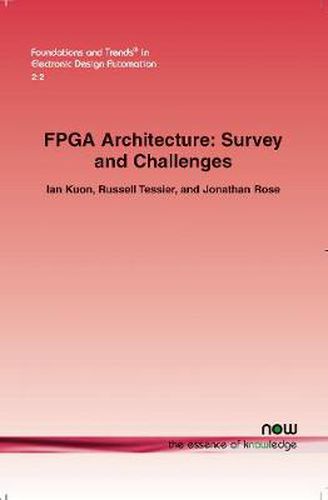Readings Newsletter
Become a Readings Member to make your shopping experience even easier.
Sign in or sign up for free!
You’re not far away from qualifying for FREE standard shipping within Australia
You’ve qualified for FREE standard shipping within Australia
The cart is loading…






This title is printed to order. This book may have been self-published. If so, we cannot guarantee the quality of the content. In the main most books will have gone through the editing process however some may not. We therefore suggest that you be aware of this before ordering this book. If in doubt check either the author or publisher’s details as we are unable to accept any returns unless they are faulty. Please contact us if you have any questions.
Field-Programmable Gate Arrays (FPGAs) have become one of the key digital circuit implementation media over the last decade. A crucial part of their creation lies in their architecture, which governs the nature of their programmable logic functionality and their programmable interconnect. FPGA architecture has a dramatic effect on the quality of the final device’s speed performance, area efficiency and power consumption.
FPGA Architecture reviews the historical development of programmable logic devices, the fundamental programming technologies that the programmability is built on, and then describes the basic understandings gleaned from research on architectures. It starts with a brief overview of programmable logic to provide a context for the subsequent sections which review the history of programmable logic, and the underlying programming technologies. The following sections define the terminology of FPGA architecture, and then describe foundations and trends of logic block architecture and routing architecture including a discussion of power management techniques and related circuit design issues.
A brief overview of the input/output structures and architectural questions in FPGAs is then presented followed by an explicit comparison between FPGAs and competing ASIC standard cell technology. It concludes with a review of some of the design challenges facing FPGAs and a look at emerging architectures for FPGAs.
This is an invaluable reference for engineers and computer scientists. It is also an excellent primer for senior or graduate-level students in electrical engineering or computer science.
$9.00 standard shipping within Australia
FREE standard shipping within Australia for orders over $100.00
Express & International shipping calculated at checkout
This title is printed to order. This book may have been self-published. If so, we cannot guarantee the quality of the content. In the main most books will have gone through the editing process however some may not. We therefore suggest that you be aware of this before ordering this book. If in doubt check either the author or publisher’s details as we are unable to accept any returns unless they are faulty. Please contact us if you have any questions.
Field-Programmable Gate Arrays (FPGAs) have become one of the key digital circuit implementation media over the last decade. A crucial part of their creation lies in their architecture, which governs the nature of their programmable logic functionality and their programmable interconnect. FPGA architecture has a dramatic effect on the quality of the final device’s speed performance, area efficiency and power consumption.
FPGA Architecture reviews the historical development of programmable logic devices, the fundamental programming technologies that the programmability is built on, and then describes the basic understandings gleaned from research on architectures. It starts with a brief overview of programmable logic to provide a context for the subsequent sections which review the history of programmable logic, and the underlying programming technologies. The following sections define the terminology of FPGA architecture, and then describe foundations and trends of logic block architecture and routing architecture including a discussion of power management techniques and related circuit design issues.
A brief overview of the input/output structures and architectural questions in FPGAs is then presented followed by an explicit comparison between FPGAs and competing ASIC standard cell technology. It concludes with a review of some of the design challenges facing FPGAs and a look at emerging architectures for FPGAs.
This is an invaluable reference for engineers and computer scientists. It is also an excellent primer for senior or graduate-level students in electrical engineering or computer science.